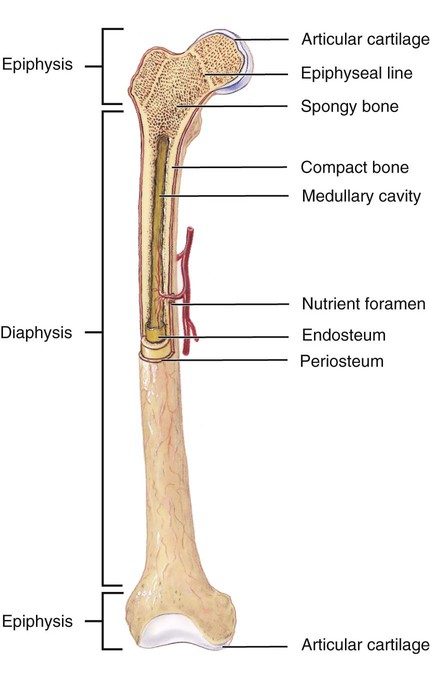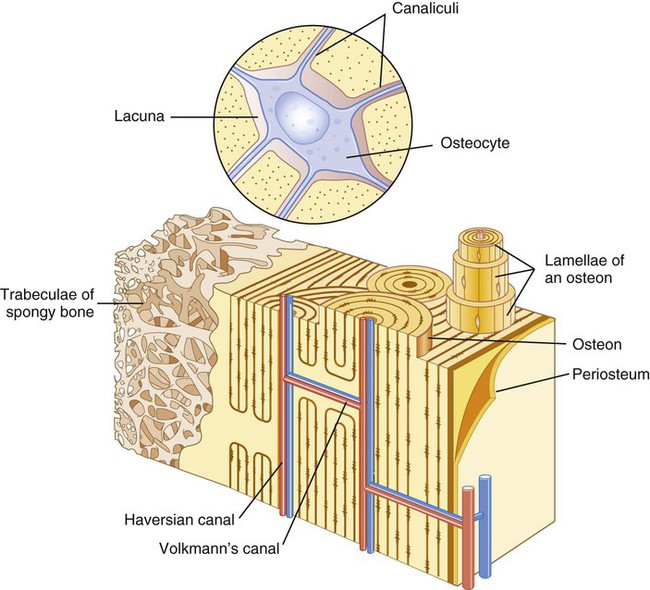1. List and describe five functions of the skeletal system. 2. Explain the difference between compact and spongy bone. 3. Classify bones according to size and shape. 4. Identify the general features of a long bone. 5. Explain the process by which long bones grow in length. 6. Explain the difference between the axial and appendicular skeletons. 7. Identify the bones of the skull. 8. Identify the structural features of vertebrae. 9. List and describe the divisions of the vertebral column. 10. Describe the structural features of the sternum and ribs. 11. Identify the parts of the pectoral girdle. 12. Identify the bones of the upper extremities. 13. Identify the parts of the pelvic girdle. 14. Identify the bones of the lower extremities. 15. List and describe the different types of joints. 16. Describe ways in which the aging of an individual affects the skeletal system. The microscopic unit of compact bone is known as the osteon (haversian system). The osteon consists of a central canal called the osteonic (haversian) canal, which is surrounded by concentric rings (lamellae) of hard, calcified matrix. Between the rings of matrix, the bone cells (osteocytes) are located in spaces called lacunae. Small channels (canaliculi) radiate from the lacunae to the osteonic (haversian) canal to provide passageways through the hard matrix. In compact bone the haversian systems are packed tightly together to form what appears to be a solid mass. The osteonic canals contain blood vessels that are parallel to the long axis of the bone. These blood vessels interconnect, by way of perforating (Volkmann) canals, with vessels on the surface of the bone. The microscopic structure of compact bone is illustrated in Figure 7-1. Spongy (cancellous) bone is lighter and less dense than compact bone (see Figure 7-1). Spongy bone consists of plates and bars of bone adjacent to small, irregular cavities that contain red bone marrow. The plates of bone are called trabeculae (trah-BEK-yoo-lee). The canaliculi, instead of connecting to a central haversian canal, connect to the adjacent cavities to receive their blood supply. It may appear that the trabeculae are arranged in a haphazard manner, but they are organized to provide maximum strength in the same way that braces are used to support a building. The trabeculae of spongy bone follow the lines of stress and can realign if the direction of stress changes. Most long bones have the same general features, which are illustrated in Figure 7-2. Diaphysis: The shaft of a long bone is called the diaphysis (dye-AF-ih-sis). It is formed from relatively thick compact bone that surrounds a hollow space called the medullary (MED-yoo-lair-ee) cavity. Medullary cavity: In adults the medullary cavity contains yellow bone marrow, so it is sometimes called the yellow marrow cavity. Epiphysis: At each end of the diaphysis, there is an expanded portion called the epiphysis (ee-PIF-ih-sis). The epiphysis is spongy bone covered by a thin layer of compact bone. The end of the epiphysis, where it meets another bone, is covered by hyaline cartilage, called the articular cartilage. This provides smooth surfaces for movement in the joints. In growing bones, there is an epiphyseal (ep-ih-FIZ-ee-al) plate of hyaline cartilage between the diaphysis and epiphysis. Bones grow in length at the epiphyseal plate. Growth ceases when the cartilaginous epiphyseal plate is replaced by a bony epiphyseal line. Periosteum: Except in the region of the articular cartilage, the outer surface of long bones is covered by a tough, fibrous connective tissue called the periosteum. The periosteum is richly supplied with nerve fibers, lymphatic vessels, blood vessels, and osteoblasts. Nutrient foramina: Blood vessels enter the diaphysis of the bone through small openings called nutrient foramina. Endosteum: The surface of the medullary cavity is lined with a thinner connective tissue membrane, the endosteum, which contains osteoclasts.
Skeletal System
Introduction to the Skeletal System
Overview of the Skeletal System
Functions of the Skeletal System
Structure of Bone Tissue
Compact Bone
Spongy (Cancellous) Bone
General Features of a Long Bone

![]()
Stay updated, free articles. Join our Telegram channel

Full access? Get Clinical Tree


Skeletal System
Get Clinical Tree app for offline access


